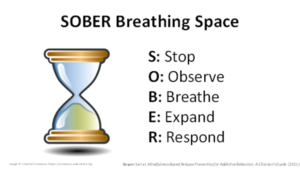
SOBER Breathing Space for Teens
This practice prompts students to practice broadening and narrowing their field of awareness so that they can be more mindful throughout the day.

This practice prompts students to practice broadening and narrowing their field of awareness so that they can be more mindful throughout the day.
Students will:
Note: As you prepare to lead this practice, you don’t need to read verbatim from a script, but rather to learn the practice yourself. Use the script as an example of the steps as well as the spirit of the practice. But in leading a practice, you can guide students using your own words, from your own moment-to moment experience.

Welcome to the SOBER breathing space.
Sober stands for Stop, Observe, Breath, Expand, and Respond.
Stop whatever it is you are doing and whatever it is you are about to do.
Allow yourself to just simply be right here in the present moment.
Observe what is happening in your body, noticing any sensations that are present in your body right now.
[Brief pause]
Check in with your emotions, noticing whatever feelings are there for you right now without judging anything–just allowing them to be as they are.
[Brief pause]
Notice where your thoughts are right now—whether they are in the past, or in the future, or in the present.
[Brief pause]
With the next breath in, gathering your awareness.
With the next breath out, bringing your awareness now just to the breath.
As best as you can, keeping your full attention on the sensations of breathing.
Breathing in—I know that I am breathing in.
Breathing out—I know that I am breathing out.
In. Out.
[Brief pause]
Whenever you notice your mind wandering, as best as you can, simply bring your awareness back to the next breath.
Breathing in, breathing out.
In. Out.
[Brief pause]
Gathering your awareness again with your next in-breath.
Breathing out, expanding your awareness to the sensation of your whole body being breathed.
Checking in again with the body—what do you notice? What sensations are present right now? Are they the same or are they different than earlier?
Checking in with your emotions—what feelings are present right now?
Checking in again with your thoughts—where is your mind right now?
And with awareness, as best as you can, responding to the situation, carrying on with your day…shifting out of autopilot mode and into mindful awareness.
Dzung X. Vo, MD (adapted with permission from Bowen, Chawla, and Marlatt, 2011: Mindfulness-Based Relapse Prevention for Addictive Behaviors: A Clinician’s Guide).
A 2014 meta-analysis that focuses on 24 mindfulness studies of K-12 students demonstrated changes in students’ attention and resilience to stress, including positive emotions, self-esteem, and self-concept. Further, a 2019 targeted review of mindfulness interventions with young adolescents indicated benefits to teens’ well-being.
“Mindful breathing” is a simple process—one that involves observing the breath and redirecting attention to the breath when the mind wanders–and is a tool that students can easily use when faced with a stressful situation.
This particular practice is helpful because it gives students an anchor for their attention: their breath as a place to focus when they might feel carried away by emotions. Students who practice mindful breathing regularly may feel less anxiety, more focus, and a greater sense of calm in the classroom.

Are you ready to build a kinder, happier school where everyone belongs? Join Greater Good Educators! Explore the science of well-being in a supportive community of educators from around the world. Registration is now open for the 2025-2026 school year!
Comments